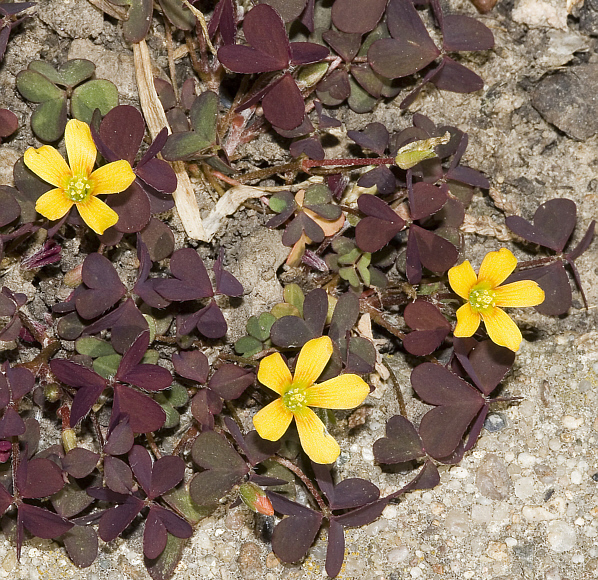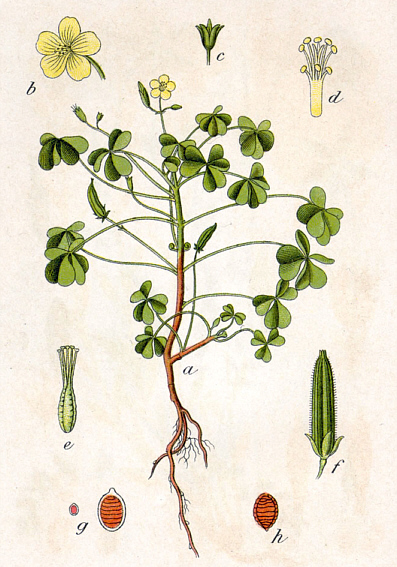

Zitierweise / cite as:
Carakasaṃhitā: Ausgewählte Texte aus der Carakasaṃhitā / übersetzt und erläutert von Alois Payer <1944 - >. -- Anhang A: Pflanzenbeschreibungen. -- Oxalis corniculata L. -- Fassung vom 2007-07-27. -- URL: http://www.payer.de/ayurveda/pflanzen/oxalis_corniculata.htm
Erstmals publiziert: 2007-07-27
Überarbeitungen: 2016-01-10 [Ergänzung]
Anlass: Lehrveranstaltung SS 2007
©opyright: Dieser Text steht der Allgemeinheit zur Verfügung. Eine Verwertung in Publikationen, die über übliche Zitate hinausgeht, bedarf der ausdrücklichen Genehmigung des Verfassers
Dieser Text ist Teil der Abteilung Sanskrit von Tüpfli's Global Village Library
WARNUNG: dies ist der Versuch einer
Übersetzung und Interpretation eines altindischen Textes. Es ist keine
medizinische Anleitung. Vor dem Gebrauch aller hier genannten Heilmittel wird
darum ausdrücklich gewarnt. Nur ein erfahrener, gut ausgebildeter ayurvedischer
Arzt kann Verschreibungen und Behandlungen machen!
Falls Sie die diakritischen Zeichen nicht dargestellt bekommen, installieren Sie eine Schrift mit Diakritika wie z.B. Tahoma.
Verwendete und zitierte Werke siehe: http://www.payer.de/ayurveda/caraka0001.htm

Abb.: Oxalis corniculata L. - Hornsauerklee
[Bildquelle:
Olaf Leillinger / Wikimedia. --
Creative
Commons Lizenz (Namensnennung, share alike)]

Abb.: Oxalis corniculata L. - Hornsauerklee
[Bildquelle: Wikipedia]
Drury:
"Oxalis corniculata (Linn.) N. O. Oxalidaceae. Yellow Wood-sorrel, Eng. Pooliaray, Tam. Poolichinta, Tel. Umbuti, Duk. Amrool, Hind.
Description. — Stems decumbent, branched, radicating, leafy ; stipules united to the base of the petioles ; leaves palmately 3-foliolate; leaflets obcordate, pubescent; peduncles 2-5, but mostly 2-flowered ; stamens monadelphous ; sepals pubescent; petals emarginate; pistils as. long as the longer stamens ; capsule many-seeded, densely pubescent; flowers yellow. Fl. Nearly all the year.— W & A.. Prod. i. 142.— Roxb. Fl. Ind. ii. 457.— Wight Icon. i. t.18.-------Common everywhere. Base of the Himalaya.
Medical Uses.—The leaves, stalks, and flowers are used by the Hindoos as cooling medicines, especially in dysentery.—(Ainslie.) It contains salts of oxalic acid, and acts as a refrigerant in fevers, as well as an antiscorbutic. Its juice may be used to remove ink-spots, as it rapidly dissolves most compounds of iron. It is used externally to remove warts, and fibres over the cornea.—(Powell's Punj. Prod.) The O. sensitiva is reckoned tonic in Java.—Ainslie."
[Quelle: Drury, Heber <1819 - 1872>: The useful plants of India : with notices of their chief value in commerce, medicine, and the arts. -- 2d ed. with additions and corrections. London : Allen, 1873. -- xvi, 512 p. ; 22 cm. -- s.v.]